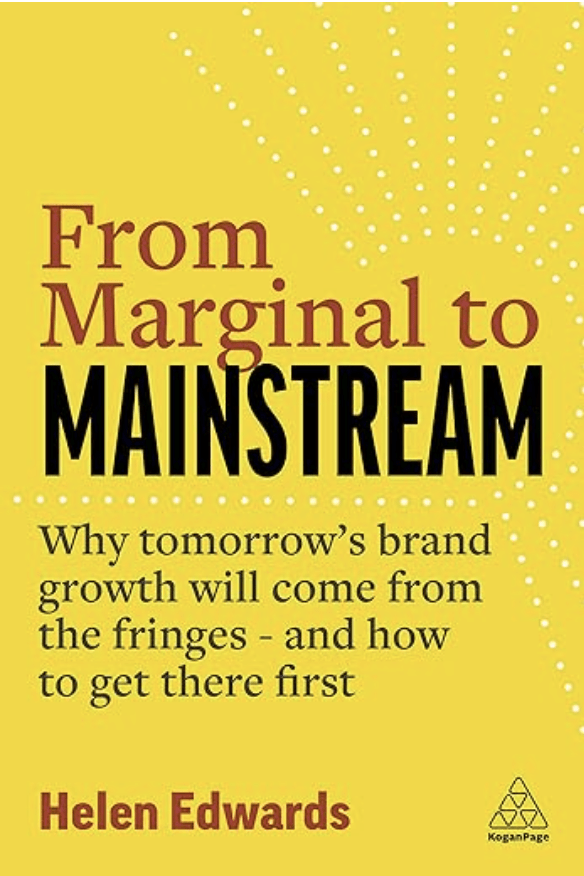As a student I once brought home a new boyfriend, who happened to be vegan, to meet my parents. My mother, who hadn’t met a vegan before, panicked – ‘can I give him salmon?’ she whispered. Now she has six grandchildren who are vegetarian or vegan and is used to accommodating their needs. What was niche and seemed a little weird is now mainstream, with exponential growth benefits for those brands and categories who predicted and leveraged the change.
Helen Edwards’ fascinating book ‘From Marginal to MAINSTREAM – why tomorrow’s brand growth will come from the fringes and how to get their first’ is filled with examples of how fringe behaviours have broken through to become mainstream. She presents an imperative for modern business to break out of the ‘low growth zone’ by looking to the fringes for the future consumer-led disruptions, and defines 8 ‘M2M Beacons’ that can help us to predict which marginal behaviours are most likely to breakthrough.
This made me think about how Paraffin’s Co-Creation Sprints can play a powerful role in helping M2M prediction and acceleration. At Paraffin we have always looked to experts and extreme users for inspiration to fuel and inspire our Innovation Sprints and have an ever-evolving database of ‘provocateurs’ who we have worked with to push our thinking and spark fresh ideas for our clients.
Here are some practical tips from our experience on how to build the M2M Beacons thinking into a Co-Creation Sprint
1. ‘Intense Advocates’ – marginal behaviour usually starts with a small group of passionate advocates who can provide insight into the drivers of the movement. Find them, observe and listen to them, bring their voice into the Sprint – they may hold the secrets to a mainstream future. For a recent Dentures project, we worked with over 60s who were extreme users of online games and social media, to inform a digital strategy for those in the demographic who were more resistant to the online world.
2. ‘Dig into Resistance’ – we often want to avoid negativity in creative sessions, but it is only by understanding the reasons why the marginal is marginal that we can anticipate changes to these barriers and predict potential positive shifts. Use resistance to fuel creativity in your Sprint. When we studied deeply the non-users of fabric conditioners, we learned how their resistance changed at key life-stage moments such as the birth of a child or moving in with someone for the first time, highlighting opportunities for brands to motivate re-evaluation at the right time. This can equally be applied to marginal behaviour.
3. ‘Re-framing’ – this is where brands have the power to shape change. Based on CBT principles, we use workshop techniques in the Sprint to explore ways to re-frame a behaviour to overcome resistance and shape a new positive narrative with mainstream potential. The classic example Helen cites is re-framing ‘vegan’ food to ‘plant-based’ opening up new appeal for those resistant the concept of veganism. Similarly, products that are designed for sustainability used to be considered less effective or boring – but many of our personal care clients have re-framed natural ingredients as powerful essences that have been harnessed to deliver real benefits.
4. ‘Dilution’ – more positive than it sounds, this is where innovation can really have an impact. We can use creative problem-solving Sprint exercises to find ways to overcome the difficulties that are limiting consumer adoption of fringe behaviour (which we understand through 1-2 above). A great example of this was the recent ‘Say Maaaate to a Mate’ campaign which gave male friendship groups an easy way to intervene in a difficult situation when they see sexist behaviour amongst their friends.
5. Co-creation – we have seen again and again how bringing articulate, creative, provocative consumers into the Sprint can supercharge your collective creativity – especially where a marginal behaviour is under scrutiny. Find our how we do it here in our recent guide to Co-creation

Do read Helen’s fantastic, inspiring and practical book, and get in touch to discuss how we can design a Marginal to Mainstream Co-Creation Sprint for you